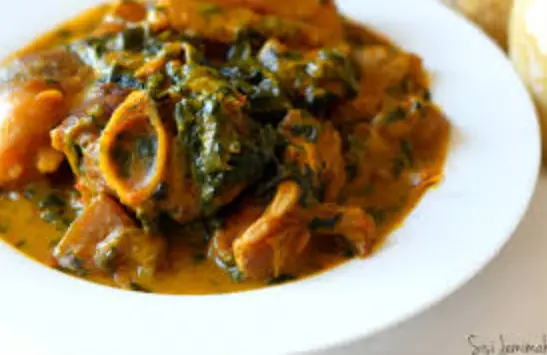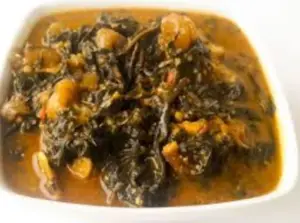
Best Ways to Prepare Bitter leaf soup

PREP: 30 Minutes
COOK: 20 Minutes
SERVES: 5 Minutes
BEST INGREDIENTS FOR BITTER LEAF SOUP
- Washed and Squeezed Bitter leaf (a handful).
- Cocoyam (10 small corms).
- Red Palm oil (2 cooking spoons), you may need a bit more.
- Assorted Fish – includes best cut, Shaki (Cow tripe).
- Pepper, Salt and Ground Crayfish (to taste).
- Traditional seasoning: Iru or Ogiri-1 teaspoon.
DIRECTIONS FOR BITTER LEAF SOUP

Preparation Directions for Bitter leaf soup
Make sure that the bitter leaves are well washed, such that there is no trace of bitterness left. If not wash and squeeze it more. If the bitterness cannot be completely washed off which usually occurs. Then You should boil it for 15 minutes and wash in cold water.
Wash and cook the cocoyam till soft. Remove the peels and use a mortar and pestle to pound the corms to a small paste.
Cooking Directions for Bitter leaf soup
- Boil the Shaki (Cow tripe), stock fish and dry fish in one litre of water till they are well done. The first sign of a well done shaki is that the will start curling on itself.
- Wash the beef and add to the pot of shaki etc, and continue cooking till when the meat is done. After that add 3 cubes of knorr or any other available spice and cook for 5 Minutes.
- Add Pepper, Grounded Crayfish, bitter leaves (If they have not been parboiled) and cook for 10 Minutes. Then add the cocoyam paste in small paste and the palm oil. In other words add all the ingredients at this stage.
- Cover the pot and leave to cook on high heat till all the cocoyam lumps have dissolved. You can add more water if you think that the soup is too thick.
- Add Salt to taste and the soup is ready.
Serve with Eba, Cassava Fufu, Semolina, Semovita, Amala, Pounded Yam.
SUMMARY ON THE PREPARATION OF BITTER LEAF SOUP
Bitter leaf soup is one of the most traditional soup in Nigeria. It is native to the Igbos of Eastern Nigeria. The name is quite misleading in that a well prepared bitter leaf soup should not have even the faintest bitterness. This achieved by washing and squeezing the bitter leaves (and changing the water at intervals) till all traces of bitterness has been washed off.
Some even add palm oil to the bitter leaf while washing in order for easy washing.

Leave a Reply